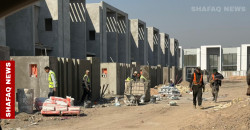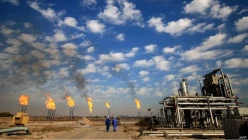Youth in despair, no jobs to share: Iraq’s workforce hanging in the air

Shafaq News/ Iraq’s labor force currently numbers around 15 million, based on the 2024 data from the Ministry of Planning. Approximately 42% of these individuals work in the public sector, an outcome rooted in decades of state-centered economic policy, first institutionalized under the Ba’ath regime and later reinforced during the post-2003 reconstruction period. This reliance on state employment has left Iraq with one of the highest public-sector workforces in the Middle East.
But the system is showing clear signs of fatigue. Government ministries and agencies now employ more than 3.7 million people, while salary and pension obligations have soared past $48 billion annually, nearly 40% of Iraq’s federal budget, according to a 2024 report by the Federal Board of Supreme Audit. Economist Basim Jameel cautioned Shafaq News that this level of spending is unsustainable. Any additional hiring, he argued, would deepen the strain on an already overburdened financial system.
With public employment nearing saturation, attention has increasingly shifted to Iraq’s private and informal sectors, which now absorb the majority of the workforce. Around 58% of working Iraqis rely on these sectors, but the jobs available are often precarious. More than 60% of private sector employment occurs informally, with workers lacking contracts, legal protections, or access to healthcare and pensions.
For many, this translates into a daily struggle for stability. Haifa Rajab, 30, works long hours at a retail shop in the New Baghdad district. Despite a monthly salary of just 500,000 dinars, she hesitates to enroll in the social security system due to the deductions it would entail. “I can’t afford to lose part of my already small salary,” she explained to Shafaq News, describing her twelve-hour shifts as both physically draining and financially limiting. Though she understands the benefits of formal protections, the cost feels out of reach.
National labor statistics compiled by the International Labour Organization (ILO) and Iraq’s Central Statistical Organization (CSO) reveal where most private sector jobs are found. Construction ranks as the largest employer at 14%, followed by retail trade (12%), transport and warehousing (9%), education (8%), and basic manufacturing (7%).
Yet employment in these sectors, particularly construction, can come with punishing conditions. Hassan Radi Mohsen, 34, from Abu Disheer, shared his experience of relying on daily labor queues for sporadic opportunities, sometimes working only once or twice a month. “My job starts at 6:00 a.m. and ends at 3:00 p.m., under brutal conditions, either scorching heat or biting cold,” he explained. “No one takes these conditions into account, not the employers, not the foremen. But we have no choice. This is how we survive.”
A 2023 ILO report confirmed what workers like Hassan have long experienced as informality, describing it as the greatest barrier to stable employment in Iraq. The report warned that widespread informal labor weakens social protection mechanisms and accelerates inequality. The impact has been particularly harsh on younger Iraqis, with around 70% of those aged 15 to 29 engaged in informal or underemployed roles.
Alongside generational divides, gender disparities continue to limit Iraq’s labor market potential. Despite making up the majority of university graduates in recent years, according to the Ministry of Higher Education, women face major obstacles to entering and remaining in the workforce.
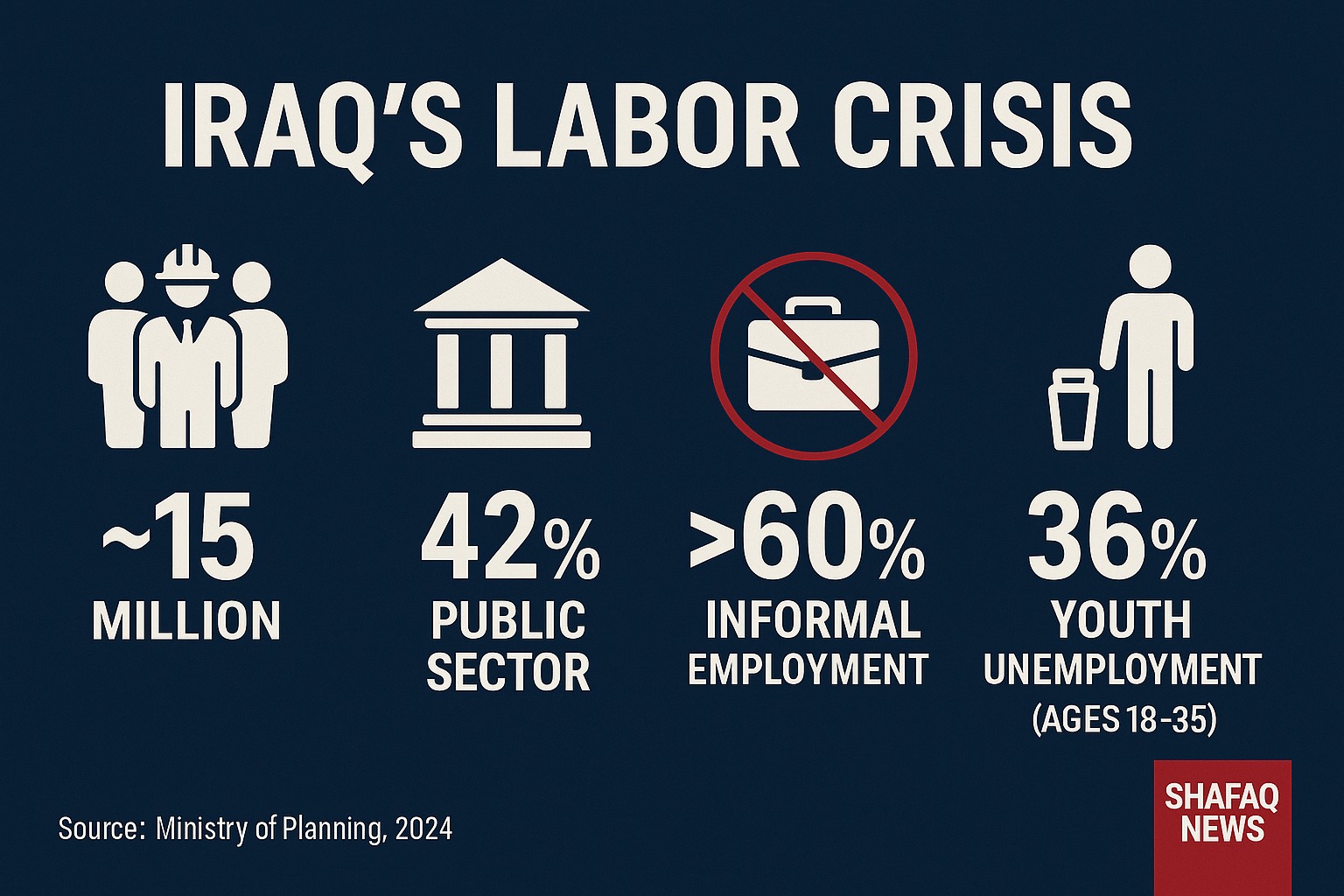
In 2024, female labor force participation was just 13.6%. In rural areas, that number fell below 5%. Cultural conservatism, inadequate childcare, transportation issues, and persistent discrimination all contribute to the gender gap.
Former Minister of Labor and Social Affairs Adel al-Rikabi emphasized the consequences of sidelining women’s economic potential during a 2023 policy forum. “We are wasting a major segment of our talent pool. Empowering women economically is not optional, it is a necessity for Iraq’s development,” he stated to Shafaq News.
Jobless Nation
While frequently promoted as a solution to Iraq’s deepening employment crisis, the private sector remains too underdeveloped to meet the demands of a rapidly growing labor force. According to the World Bank’s 2023 Iraq Economic Monitor, fewer than 5% of private firms employ more than 10 workers. Over 80% of registered businesses are family-run microenterprises, many lacking the structure or resources to expand meaningfully.
This limited private sector capacity has led to a pronounced mismatch between job creation and labor market needs. Iraq’s private sector generates fewer than 50,000 formal jobs each year, a figure that falls far short of absorbing the more than 400,000 young people entering the workforce annually. The resulting strain has driven youth unemployment to alarming levels. By late 2024, over 36% of Iraqis aged 18 to 35 were unemployed, according to the Ministry of Youth and Sports. In governorates like al-Muthanna, Dhi Qar, and Basra, the rates climb even higher, surpassing 50%.
For many young Iraqis, even higher education fails to open doors to meaningful employment. Rusul Faleh, a 25-year-old mechanical engineering graduate from Karbala, has spent nearly two years searching for work aligned with her qualifications. “I send my CV everywhere, ministries, private firms, NGOs,” she shared with Shafaq News. “Most never reply, and the ones that do offer positions in sales or admin work for barely enough to cover transportation.”
Each year, more than 200,000 students complete their education, yet only a small fraction secure employment matching their academic backgrounds. The number of unemployed graduates has already surpassed 600,000. With limited opportunities, many are forced to take on jobs unrelated to their fields or seek work abroad, often under precarious or exploitative conditions.
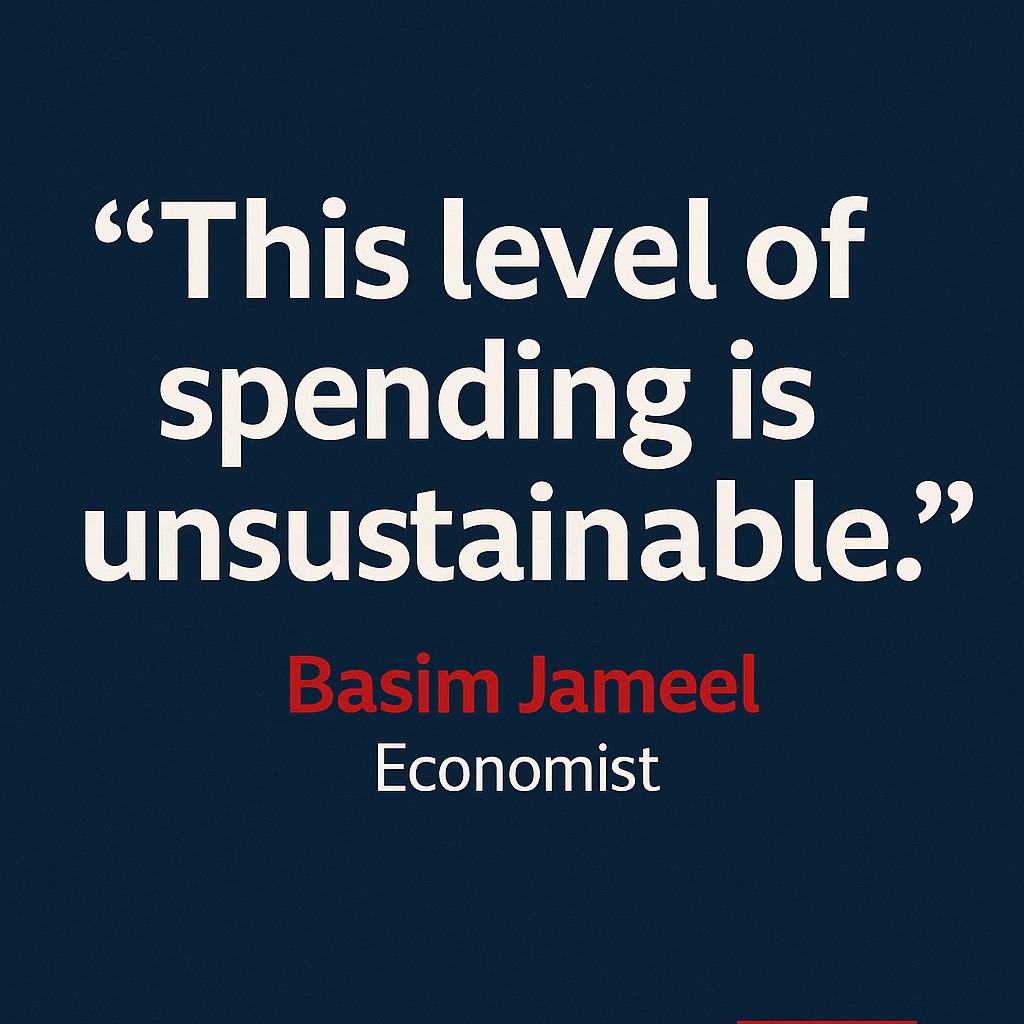
The broader picture reflects a labor market under strain. Iraq’s national unemployment rate stands at approximately 16%, based on international models cited by the Ministry of Labor and Social Affairs. Yet this figure conceals deeper structural challenges. Youth unemployment remains exceptionally high at 36%, marking one of the steepest rates in the region.
In an interview with Shafaq News, labor advocate Ihsan al-Danbous underscored the broader implications of widespread unemployment among graduates. He warned that the absence of viable job prospects could threaten long-term social stability. Al-Danbous called for stronger enforcement of labor laws, tighter regulation of foreign labor practices, and greater authority for unions to protect workers’ rights.
Rules on Paper, Rights in Vapor
In 2015, Iraq passed Labor Law No. 37, aiming to overhaul the country’s labor market and align it with International Labour Organization (ILO) standards. The law introduced progressive reforms, including minimum wage protections, working hour regulations, a ban on child labor, rights for workers to unionize, access to social security, and work in safe conditions. However, nearly a decade later, many of these protections remain largely unimplemented, particularly in the private sector.
Despite the progressive nature of the law, implementation has faltered. Labor inspections, intended to monitor compliance, are sporadic, and many employers continue to sidestep their legal responsibilities. Workers, particularly in the private sector, are left exposed to exploitation without the protections they are entitled to.
Sattar al-Danbous, the head of Iraq’s General Federation of Trade Unions, emphasized to Shafaq News the scale of these violations, pointing out that "employers continue to ignore legal obligations, including mandatory social security coverage and basic worker protections." For many, job security, fair wages, and regulated working hours remain elusive.
However, amid these challenges, there are signs of gradual change. Union leaders like Walid Naama, head of the Iraqi Federation of Trade Unions, are working to address the gaps in labor regulation.
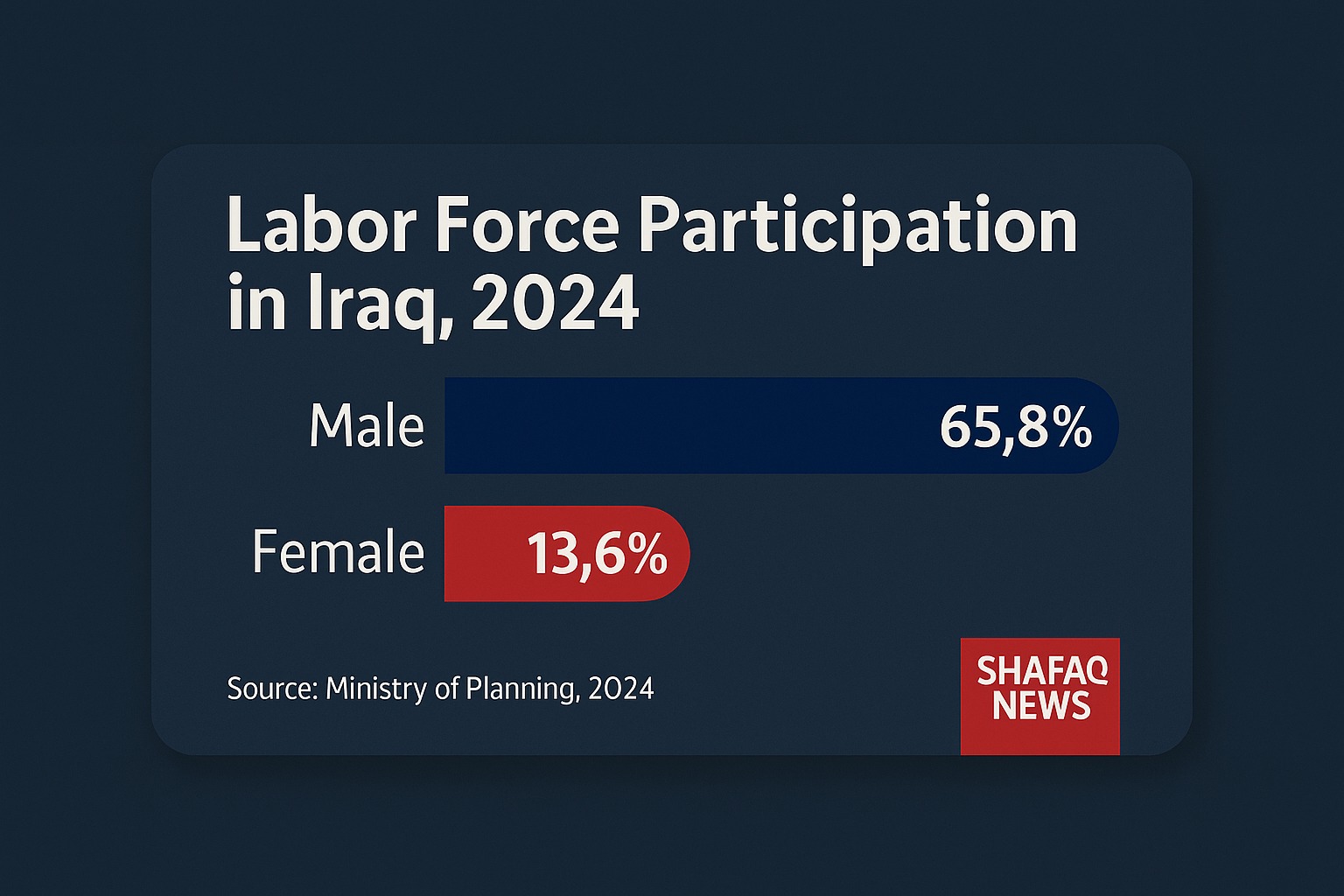
Naama shared that a new law is currently under development to better regulate union activities for skilled workers. He expressed optimism that this initiative, along with ongoing efforts to draft clearer regulations for foreign labor, could help level the playing field for Iraqi workers.
"Without clear regulations for foreign labor, the local workforce remains at risk," Naama cautioned, stressing that the private sector's growth must be accompanied by stronger safeguards for domestic employment.
In the meantime, progress is being made on other fronts. The contributions of Iraq’s social security law, for example, have been instrumental in making the private sector more competitive with public sector jobs.
This framework has provided workers with greater job security and contributed to safer working environments. While there is still much to be done, Naama's experience with previous legislative changes, such as the passage of Labor Law No. 37 and the Union Organization Protection Law in 2017, suggests that Iraq’s labor laws are gradually evolving in ways that could improve conditions for the country’s workforce in the long term.
Local Jobs Squeezed
Foreign labor is becoming increasingly visible across Iraq, from restaurants and cafes to state institutions and construction sites. Facilitated by specialized companies and contracts, the influx of foreign workers has gone largely unregulated, contributing to the growing unemployment crisis among Iraqis.
Najm Al-Aqabi, spokesperson for the Ministry of Labor and Social Affairs, revealed to Shafaq News, "The number of licensed foreign workers in Iraq currently exceeds 42,000." However, experts warn that many more remain unlicensed. Fadel Al-Gharawi, head of the Strategic Human Rights Center in Iraq, estimates, "Indicators suggest there are onemillion undocumented foreign workers in Iraq."
The construction industry has seen a particularly noticeable rise in foreign labor, with workers from India, Bangladesh, and Pakistan filling roles once occupied by Iraqis.
Ali Mohammed, a 47-year-old Iraqi, explained why he opted for foreign labor in his home construction, "There are clear reasons behind this choice, including the lower cost of foreign workers compared to locals, as well as their high efficiency and productivity."
Mohammed pointed out, "Foreign workers work 10 hours a day without requesting breaks or meals, and foreign master builders require fewer workers to complete tasks, reducing overall construction costs." As an example, he noted, "An Iraqi master builder would need four workers, while a foreign one requires just one."
This trend is not new. Economic expert Hammam Al-Shamaa shared with Shafaq News that "its roots go back to the 1980s when Egyptian workers dominated the construction sector due to most Iraqi workers being engaged in mandatory military service at the time." Although the trend waned in the 1990s, Al-Shamaa observed, "It has resurged significantly in recent years."
Iraqi workers face several challenges that have led to this shift, including a preference for office jobs over manual labor and attitudes that make them reluctant to engage in physically demanding sectors. "This has led many employers to prefer foreign workers, who are known for their commitment and lack of tribal affiliations," Al-Shamaa added.
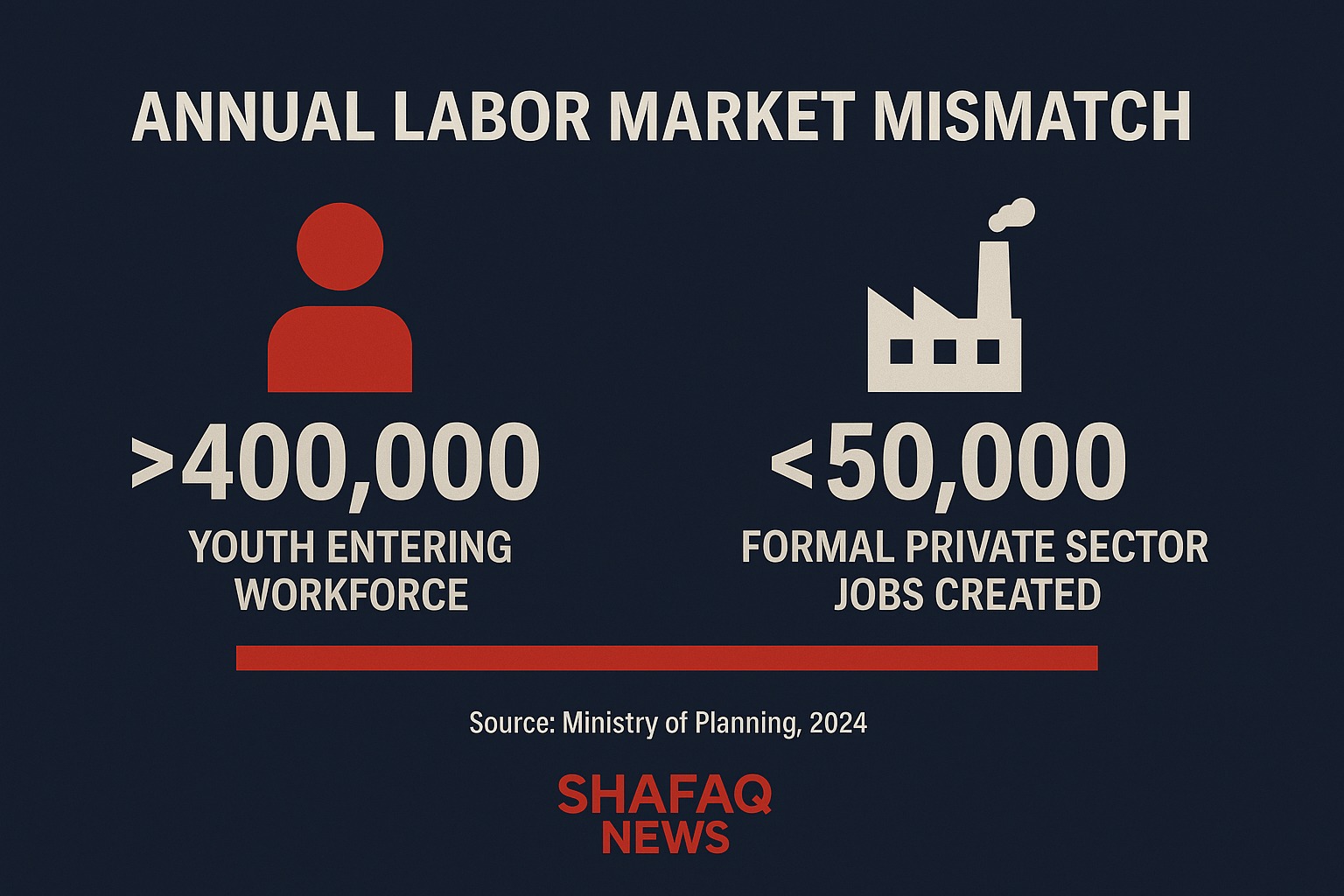
Hopeful Hints
In response to these ongoing challenges, the Ministry of Labor and Social Affairs has launched several initiatives to boost domestic employment and regulate foreign labor in Iraq.
Hassan Khuwam, spokesperson for the Ministry, underscored the significance of Iraqi workers in revitalizing the national economy, remarking, “Workers are the backbone of Iraq’s economy.” He noted that Labor Day serves as a timely reminder of the urgency to address soaring joblessness and the unchecked influx of foreign laborers operating outside legal frameworks.
One of the ministry’s key achievements in recent months is the passage of the Social Security and Retirement Law for private-sector workers. The law is designed to narrow the gap between public and private employment by offering private-sector employees stronger protections and long-term financial security. By addressing these disparities, the law seeks to encourage more Iraqis to enter and remain in private employment, an area long overshadowed by public sector jobs with greater benefits.
Complementing these legislative reforms, the ministry has introduced a loan program targeting small-scale industries. Factory and workshop owners are eligible for loans ranging from 20 to 50 million Iraqi dinars on the condition that they hire Iraqi workers and register them with the national social security system. This initiative is part of a broader effort to stimulate job creation while promoting workforce formalization.
To connect job seekers with potential employers, the Ministry has also expanded its digital “Mihan” (Professions) platform. The service allows individuals to register their skills and match with employers across various sectors. It is supported by a nationwide network of 37 vocational training centers operating in Baghdad and several provinces. These centers offer targeted training programs aligned with labor market needs, aiming to equip Iraqis with the skills required by modern industries.
In parallel, the Ministry of Interior has intensified efforts to confront the presence of undocumented foreign laborers. A recent Cabinet resolution has further reinforced domestic employment priorities by mandating that private companies maintain a workforce that is at least 80% Iraqi.
Moreover, nearly 700 foreign nationals have been arrested for violating the Foreigner Residence Law No. (76) of 2017. Authorities have urged both companies and individuals to deport those in violation of the law by January 15, 2025. To support legal compliance, the Ministry has relaunched an electronic platform that allows foreign workers to regularize their residency status, including in the Kurdistan Region.
Looking ahead, the government’s National Development Plan for 2024–2028 outlines ambitious goals: a reduction in unemployment from 16% to 10% and an average annual economic growth rate of 4.25%. While these targets reflect a strategic vision for economic revitalization, critics argue that the reforms alone may not be enough to tackle the structural deficiencies of the labor market.

